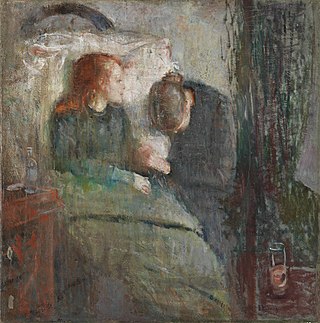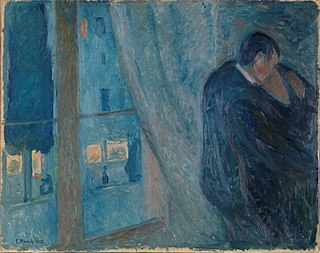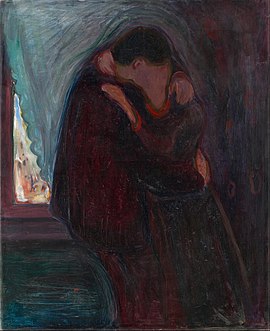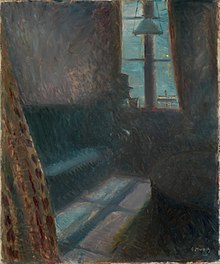
Edvard Munch was a Norwegian painter. His 1893 work, The Scream, has become one of Western art's most acclaimed images.

The Scream is a composition created by Norwegian artist Edvard Munch in 1893. The Norwegian name of the piece is Skrik (Scream), and the German title under which it was first exhibited is Der Schrei der Natur. The agonized face in the painting has become one of the most iconic images in art, seen as symbolizing the anxiety of the human condition. Munch's work, including The Scream, had a formative influence on the Expressionist movement.

Madonna is the usual title given to several versions of a composition by the Norwegian expressionist painter Edvard Munch showing a bare-breasted half-length female figure created between 1892 and 1895 using oil paint on canvas. He also produced versions in print form.

The Kiss is an oil-on-canvas painting with added gold leaf, silver and platinum by the Austrian Symbolist painter Gustav Klimt. It was painted at some point in 1907 and 1908, during the height of what scholars call his "Golden Period". It was exhibited in 1908 under the title Liebespaar as stated in the catalogue of the exhibition. The painting depicts a couple embracing each other, their bodies entwined in elaborate beautiful robes decorated in a style influenced by the contemporary Art Nouveau style and the organic forms of the earlier Arts and Crafts movement.

The Sick Child is the title given to a group of six paintings and a number of lithographs, drypoints and etchings completed by the Norwegian artist Edvard Munch between 1885 and 1926. All record a moment before the death of his older sister Johanne Sophie (1862–1877) from tuberculosis at 15. Munch returned to this deeply traumatic event repeatedly in his art over a period of more than 40 years. In the works, Sophie is typically shown on her deathbed accompanied by a dark-haired, grieving woman assumed to be her aunt Karen; the studies often show her in a cropped head shot. In all the painted versions Sophie is sitting in a chair, obviously suffering from pain, propped by a large white pillow, looking towards an ominous curtain likely intended as a symbol of death. She is shown with a haunted expression, clutching hands with a grief-stricken older woman who seems to want to comfort her but whose head is bowed as if she cannot bear to look the younger girl in the eye.

Puberty is an 1894–95 painting created by Norwegian artist Edvard Munch. Puberty has associations with both symbolism and expressionism, the former a movement from which Munch emerged, and the latter a movement in which Munch was pivotal. It is part of an informal series or cycle of paintings, prints, and images known as The Frieze of Life, that Munch created in 1890s, although he often revisited and explored themes and images from the series throughout his career. The painting was also done as a lithograph and an etching by Munch.

Hjalmar Eilif Emanuel Peterssen was a Norwegian painter. He is most commonly associated with his landscapes and portraits. He gained early recognition for the history painting Christian II signing the Death Warrant of Torben Oxe and established himself as one of Norway's foremost portrait painters, with portraits of, among others, Henrik Ibsen and Edvard Grieg. He also became known for his landscape paintings, and became part of the artist circle known as the Skagen Painters. He also became known for his design in 1905 of Norway's national coat of arms with the Norwegian lion, which was used by the government and the royal house. The design is still used in the royal coat of arms and the royal flag.

Melancholy is a painting by the Norwegian artist Edvard Munch. Munch painted multiple variant versions of the expressionist work in oil on canvas during the period 1891–1893. The painting depicts a man with his head resting in his hand in a pensive mood at the edge of a shoreline.

Love and Pain is an 1895 painting by Edvard Munch; it has also been called Vampire, though not by Munch. The painting depicts a man and woman embracing, with the woman kissing the man on his neck. Munch painted six different versions of the same subject between 1893 and 1895. Three versions are in the collection of the Munch Museum in Oslo, one is held by the Gothenburg Museum of Art, one is owned by a private collector, and the final work is unaccounted for. Munch painted several additional versions and derivatives of the work later in his career.

Model by the Wicker Chair is a 1919–1921 painting by the Norwegian artist Edvard Munch that is in the collection of the Munch Museum in Oslo.

Inger on the Beach is a painting by the Norwegian artist Edvard Munch. It was created in the summer of 1889, at Åsgårdstrand and is a portrait of Munch's youngest sister Inger.

The Kiss by the Window is an 1892 oil-on-canvas painting by the Norwegian artist Edvard Munch, now in the National Gallery of Norway. It forms part of his series known as The Frieze of Life, which treats the cycle of life, death and love and was produced between 1893 and 1918.

The Dance of Life or Life's Dance is an 1899–1900 expressionist painting by Edvard Munch, now in the National Museum of Art in Norway. The arch of life spans from white young virgin in white over the pair with red wife to an old widow in black.

Gina Beavers is an American artist based in the New York area. She first gained attention in the early 2010s for thickly painted, relief-like acrylic images of food, cosmetics techniques and bodybuilders appropriated from Instagram snapshots and selfies found using hashtags such as #foodporn, #sixpack and #makeuptutorial. Her later work has continued to recombine these recurrent subjects, as well as explore memes, irreverent conflations of genres or art history and kitsch, identity, fandom and celebrity-worship. In 2019, New York Times critic Martha Schwendener described her paintings as "canny statements on contemporary bodies, beauty and culture … [that] tackle the weirdness of immaterial images floating through the ether, building them up into something monumental, rather than dismissing them."
Arne Kristian Eggum is a Norwegian art historian who mainly focused his scientific work on Edvard Munch.

Ashes is an oil on canvas painting by the Norwegian symbolist painter Edvard Munch. Painted in 1894–95 it is now in the collection of the National Gallery of Norway in Oslo.

Self-Portrait with Cigarette is an 1895 painting by the Norwegian artist Edvard Munch. Munch's use of the cigarette and physical decay as a rejection of societal values aroused controversy following the self-portrait's 1895 exhibition. As of 2021, the work is held by the National Gallery in Oslo.

Death and the Child is a composition created by Edvard Munch in 1889. Since 1918 it is located in the Kunsthalle Bremen. It depicts a little girl at her mother’s deathbed who is looking at the viewer in a fearful manner. A second, thus far unknown painting of the artist was discovered underneath the canvas in 2005. A new version of that motif, which refers to Munch’s family and the early death of his mother was created between 1897 and 1899 and is now hanging in the Munch Museum in Oslo. An etching was made in 1901 with this motif.

Inheritance is an oil painting on canvas created by the Norwegian painter Edvard Munch (1863–1944). It depicts a mother with syphilis holding her baby, who is affected by congenital syphilis. Munch completed the work after visiting the Hôpital Saint-Louis in Paris, where he saw a woman crying for her child with the disease.




















